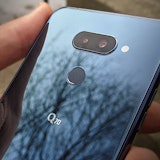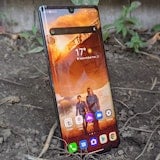
The LG G3 originally copped a lot of flak, being released around 6 months after its predecessor. Yet, in that short time, LG has managed a huge leap ahead in its flagship offering. The G3 is a fantastic phone with a beautiful user interface, solid camera and reliable battery life.
It’s not without its flaws, however. It can be prone to random lag and app crashes at times.
Pros:
- Beautiful user interface (UI)
- Great camera
- Fantastic quad-HD display
- Tiny bezels make it look almost next-gen
- Great customization
Cons
- Occasional lag
- More app and system crashes than other devices
- Slightly too big for easy one-handed use
Design

Despite how it looks, the LG G3 is not a metallic device. The plastic rear plate has been cleverly etched to give it the appearance of metal grain. This is actually not that disappointing. LG has done a far better job than Samsung did when it tried the same thing on the Galaxy S3 and S4. Even once you know it’s plastic it still looks pretty and is pleasant to hold. It doesn’t have the premium feel of the HTC One (M8), but it’s still an example of how a simple design can have its own beauty.
As a bonus, plastic is significantly lighter than metal. Given the width of the G3, which is still a bit phone even if LG has done well to keep the size down, any added weight would have made one-handed operation a precarious business.

It’s far from bulky, we’d have liked it to be a little smaller. The 5.5 inch display is surrounded by impressively-thin bezels that help to keep the size down and really do make it look almost next-gen when put next to something like the Galaxy S5.

The rear-situated volume and lock buttons are back again. This is a divisive issue within the office, but I’m personally a fan. Once you get used to the layout, it works well with a device this size. It’s definitely better than awkwardly stretching your hand to reach a button on the opposite side, and as such has the benefit of being as comfortable for lefties as it is for righties.
Once you get in to the user interface you start to see the real changes made by LG. Where the LG G2 was Spartan, even boring, the LG G3 has one of the prettiest UIs on Android right now. In many respects it mimics what we know to be coming on the Android L update slated for later this year.
Icons are simple with clear edges and a 2D look. Transitions are well animated and the whole ethos appears to have been “make it look fun”. Our favorite bit of animation is triggered when swiping to unlock. The lock screen fades away gradually and unevenly, revealing the home screen hidden below as you do.

If you haven’t opted to lock your phone with a password or Knock Code, you can put up to 5 app icons on the lock screen. In a fantastic piece of customisability, LG lets you decide which apps to put here. The UI is replete with this level of personalization, and it’s one of the things that makes the G3 a treat. Unfortunately, using these app shortcuts can often cause quite a bit of lag, which detracts unnecessarily from the whole affair.

The icon tray at the bottom of the home screen is customizable, too. This isn’t exactly something new, but it is a feature that is curiously left out of some phones.
All of this pales in comparison to LG’s most brilliant piece of personalization: the default on-screen buttons are yours to move, erase and add as you please. Don’t use the multitasker button? Fine, ditch it and replace it with Qslide or Dual Window. Unfortunately there isn’t an option for the old Android Menu button standard, which would have been great. You can even chose between white, black or gradients of each.

Finally, our last favorite little personal touch is colour themed folders. It may not sound like much, but being able to switch up the color of your icon folders really lightens up your home screen. It’s much nicer than the default dark options that sit in stark contrast to the colorful and fun direction in which Android is moving.
Pretty much the only thing that isn’t customizable are the default volume+- activations. Holding Volume - takes you straight to the camera and volume + launches QMemo+. You can turn this ability off if you like, but you can’t change what apps are launched by holding either button.
Camera
The camera is pretty good. It excels in daylight, where it’s one of the best options on the market. Autofocus is almost instantaneous, the shutter speed is very quick and color accuracy is high. It captures a level of detail that is unsurpassed by most other handsets we’ve used.
As you lower the light levels things get a little variable. At night, in a well-light room, sometimes you’ll get a truly great shot and sometimes things come out a little blotchy. Not blurry, mind you, it’s almost like you’ve put a water-color filter over the image. The ratio seems to be about half-half in terms of usable vs Von Gogh painting.
Flash photography is also a mixed-bag. The photos themselves come out well, suffering little or none of the washed-out look that is all too familiar with night shots. Unfortunately, this is only really good for non-living targets. The flash itself is so bright that it’s borderline impossible to keep your eyes open when it goes off. It also takes a while to actually capture an image, so you’re left staring in to what may as well be the center of the sun for well over a second. Accordingly, you may end up with a lot of half-closed eyelids and faces that blurred as they were rapidly turned away to shield their owners from the blinding onslaught.
Battery life and management

Battery life is very good, but doesn’t quite make the 2-day Holy Grail. Generally we got about a day and a half out of it. In the real world that translates to charging it every night, but never having to worry about running out before the day’s end.
Some more-taxing games did use a lot of charge and had us around 10% by bed time, but that’s standard for any device on the market.
Built-in to the G3 is a battery management system. Like the rest of the UI, this is customizable. You can set which services and features to disable when it activates, as well as what percentage of battery life causes it to switch on. You can also set it as a quick setting in the notification panel, so that you can manually turn it on and off as needed.
In some regions, the wireless charging capabilities are built right in to the phone’s rear case. This is great to see. Too often manufacturers charge you for additional charging accessories to achieve this.

The Qi wireless charging standard is the one used by LG, so any Qi device will do it. There’s a proprietary LG wireless charging stand if you’d prefer to stay in-brand. From our tests it works very well and charges about the same as plugging your phone directly in to a wall outlet.
Performance

This is where the LG G3 falters. Where most phones tend to nail the big things like smoothness, speed and stability but get tripped up on the little things, the G3 is the opposite. For all of its customization, its beautiful interface and elegant look, it just doesn’t run as efficiently as other devices.
It’s not a total lost-cause; it’s just not as good as it should be. Opening apps is sometimes fast, but can often take way longer than you’d expect. Apps also crash a bit more often than on other devices, and we even had two full system crashes where we had to remove the battery to restart the device.
These are not problems from which a modern flagship phone should suffer.

In fairness to the G3, it still works like a flagship most of the time. It’s fast smooth and, thanks to its UI, appears to move with an elegance not found on other phones. LG came so close to making an absolute market-buster here, but the software side of things seems to be holding it back.
There’s light at the end of the tunnel. Already we’ve received two software updates that have made minor improvements to things like browsing and battery management, so at the very least LG is taking the G3 seriously. Still, you should never buy a phone based on updates that may or may not ever make it to the airwaves, and as things stand the G3 could use a fair amount of improvement.
Connectivity

This is not an issue with the G3. It runs well over 3G, 4G and WiFi. WiFi connectivity goes all the way up to the most-modern 802.11ac standard, but you can still get a/b/g/n if your router is a little older.
As for 4G connectivity the G3 has it all: Cat4, FDD, TDD, 700MHz compatibility. In South Korea there will soon be a Cat6 version launching, but that’s not something anyone outside of SK needs to worry about.
If you’d like that again in English it basically means the LG G3 will operate on any current 4G network in the western world at the max speeds said network is capable of delivering to your location at any point in time.
If you’re living in a 3G area then the G3 has you covered, too. It has the latest and greatest in 3G tech, including dual-channel HSPA+ for any tech-heads out there.
Other connectivity specs:
- Bluetooth 4.0
- USB 2.0
- NFC
- A-GPS
Verdict

The LG G3 is an awesome, awesome phone that is let down by some inherent unreliabilities resulting from LG’s proprietary UI. It’s so close to being the best phone ever released that we can almost taste it.
It’s still a fantastic phone; one of our absolute favourites to be released this year. It may sound crazy, but the simple intelligence of its layout, complete with huge potential for personalisation, offset most of the instability issues.
Subsequently we’d rate it around the HTC One (M8) or Galaxy S5 mark, which is very high. It could have been higher, if it were only a little more reliable. At the very least LG has proven that it’s a name to look out for in the smartphone market. Come the LG G4 we may see a serious game-changer.
For now, the LG G3 is a great phone and well-worth your consideration. Just be aware that you may have to restart your phone a little more often than your friends, which is the price you pay for an otherwise beautiful experience.
Related Articles
Find Better Phones and Plans
Hundreds of cell phone plans unpacked. All the facts. No surprises.









































